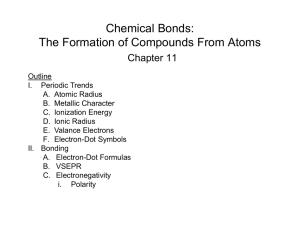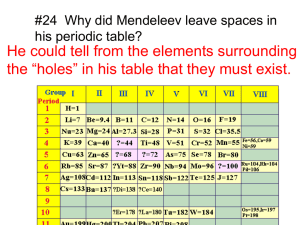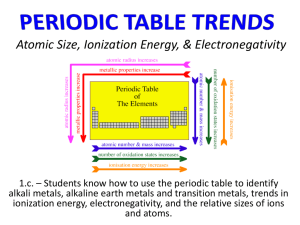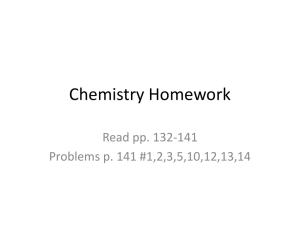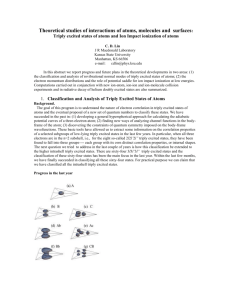Theoretical studies of interactions of atoms, molecules and surfaces
advertisement
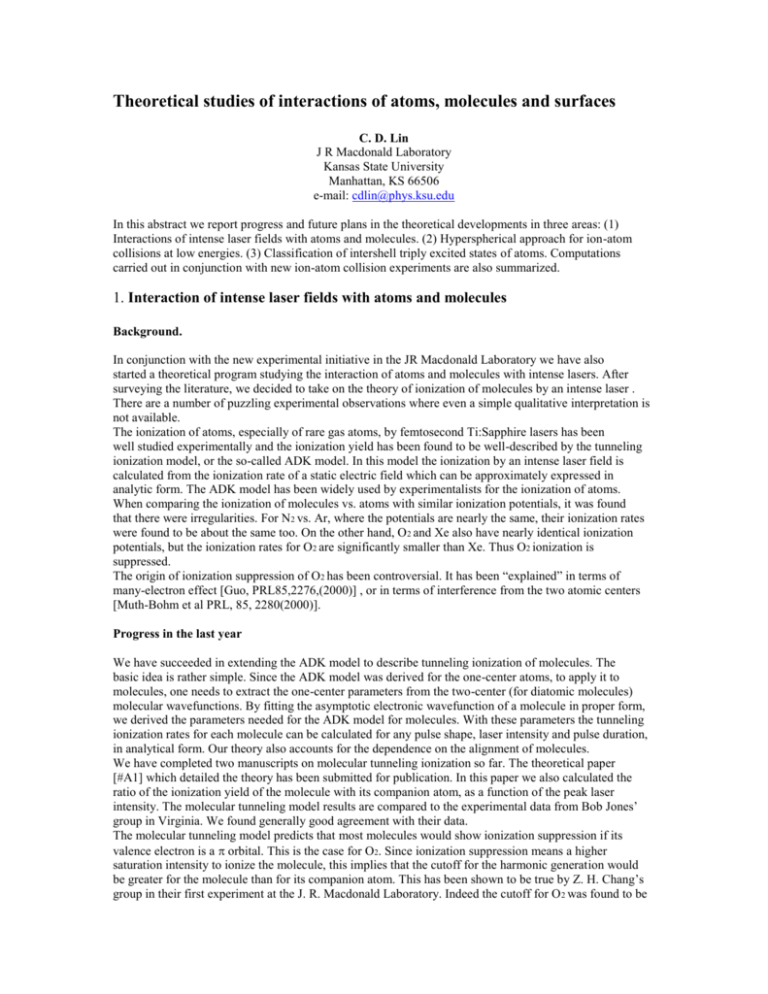
Theoretical studies of interactions of atoms, molecules and surfaces
C. D. Lin
J R Macdonald Laboratory
Kansas State University
Manhattan, KS 66506
e-mail: cdlin@phys.ksu.edu
In this abstract we report progress and future plans in the theoretical developments in three areas: (1)
Interactions of intense laser fields with atoms and molecules. (2) Hyperspherical approach for ion-atom
collisions at low energies. (3) Classification of intershell triply excited states of atoms. Computations
carried out in conjunction with new ion-atom collision experiments are also summarized.
1. Interaction of intense laser fields with atoms and molecules
Background.
In conjunction with the new experimental initiative in the JR Macdonald Laboratory we have also
started a theoretical program studying the interaction of atoms and molecules with intense lasers. After
surveying the literature, we decided to take on the theory of ionization of molecules by an intense laser .
There are a number of puzzling experimental observations where even a simple qualitative interpretation is
not available.
The ionization of atoms, especially of rare gas atoms, by femtosecond Ti:Sapphire lasers has been
well studied experimentally and the ionization yield has been found to be well-described by the tunneling
ionization model, or the so-called ADK model. In this model the ionization by an intense laser field is
calculated from the ionization rate of a static electric field which can be approximately expressed in
analytic form. The ADK model has been widely used by experimentalists for the ionization of atoms.
When comparing the ionization of molecules vs. atoms with similar ionization potentials, it was found
that there were irregularities. For N2 vs. Ar, where the potentials are nearly the same, their ionization rates
were found to be about the same too. On the other hand, O 2 and Xe also have nearly identical ionization
potentials, but the ionization rates for O2 are significantly smaller than Xe. Thus O2 ionization is
suppressed.
The origin of ionization suppression of O2 has been controversial. It has been “explained” in terms of
many-electron effect [Guo, PRL85,2276,(2000)] , or in terms of interference from the two atomic centers
[Muth-Bohm et al PRL, 85, 2280(2000)].
Progress in the last year
We have succeeded in extending the ADK model to describe tunneling ionization of molecules. The
basic idea is rather simple. Since the ADK model was derived for the one-center atoms, to apply it to
molecules, one needs to extract the one-center parameters from the two-center (for diatomic molecules)
molecular wavefunctions. By fitting the asymptotic electronic wavefunction of a molecule in proper form,
we derived the parameters needed for the ADK model for molecules. With these parameters the tunneling
ionization rates for each molecule can be calculated for any pulse shape, laser intensity and pulse duration,
in analytical form. Our theory also accounts for the dependence on the alignment of molecules.
We have completed two manuscripts on molecular tunneling ionization so far. The theoretical paper
[#A1] which detailed the theory has been submitted for publication. In this paper we also calculated the
ratio of the ionization yield of the molecule with its companion atom, as a function of the peak laser
intensity. The molecular tunneling model results are compared to the experimental data from Bob Jones’
group in Virginia. We found generally good agreement with their data.
The molecular tunneling model predicts that most molecules would show ionization suppression if its
valence electron is a orbital. This is the case for O2. Since ionization suppression means a higher
saturation intensity to ionize the molecule, this implies that the cutoff for the harmonic generation would
be greater for the molecule than for its companion atom. This has been shown to be true by Z. H. Chang’s
group in their first experiment at the J. R. Macdonald Laboratory. Indeed the cutoff for O 2 was found to be
much higher than for Xe, but N2 and Ar have an essentially identical cutoff. A combined experimental and
theoretical paper on this work has been submitted for publication [see #A2].
Future Plans
Our molecular tunneling ionization model also predicts the dependence of ionization rates on the
alignment of molecules. In the coming year we will calculate the ionization yields for molecules that are
aligned. It is well known that molecules exposed to a short pulse laser will be found partially aligned at
each “revival” time. We will calculate the ionization rates of molecules in the short interval near the revival
period which can be tested experimentally. We expect the dependence for O 2 and N2 to be quite different.
Our tunneling model has been applied to molecules near the equilibrium internuclear distance so far.
To understand the dissociation of molecules we need to obtain the ionization rates of molecules and
molecular ions at all internuclear distances. We hope to extend the present tunneling model to all
internuclear distances, to account for the so-called charge resonance enhancement effect in the tunneling
model as well.
2. Hyperspherical approach to ion-atom collisions at low energies
Background
Ion-atom collisions at low energies are usually carried out using the close-coupling expansion with
molecular orbitals. This is the so-called Perturbed Stationary State (pss) approximation. While the pss
model is widely used, this “standard” approach has serious fundamental difficulties since the theory is not
Galilean invariant. In the past few decades translational factors were introduced in an ad hoc manner to
account for such a deficiency. The validity of such an approach is difficult to assess. It is well-known that
the problems associated with the pss model can be avoided if the collision theory is formulated using
hyperspherical coordinates. However, the hyperspherical approach has not been used for ion-atom
collisions so far since one has to sum over thousands of partial waves to obtain a converged scattering cross
section. However, in previous studies, we have shown that simplified calculations are possible.
Progress in the last year
In the last two years, we have developed the computer codes needed to perform close-coupling
calculations for ion-atom collisions in hyperspherical coordinates. We formulated the theory in the
bodyframe
of the quasi-molecule. To avoid calculating the nonadiabatic coupling terms directly we adopted the
slow discretized variable approach. From the S-matrix the differential as well as total inelastic scattering
cross sections can be extracted.
In the last months, we finally have all the programs developed and a first calculation has been carried
out. We calculated the charge transfer cross sections for He++ on H from 500 eV down to about 10 eV in
the center-of-mass frame. In this energy region, the cross section drops by a factor of about 10 6. We have
found that our results differ significantly from calculations based on the molecular orbitals with
translational factors. At higher energies the discrepancy becomes smaller. There are no experimental data
available for comparison but our results at low energies agree with another calculation that uses expansion
of the wavefunction in two sets of Jacobi coordinates. It is difficult to generalize the latter method to other
systems.
Future plans
Our goal for this project is to provide benchmark results for simple ion-atom collision systems. We
intend to explore the energy region from subdegree Kelvins up to about a few keV’s where the
semiclassical approach can be used. We expect to study basic systems such as H++H for the excitation
and charge transfer at low energies, electron capture of H by multiply charged ions where some
experiments are available from the merged-beam experiments at ORNL. By treating atoms or ions using
model potentials we expect to be able to study their collisions at low energies as well.
In the future, we can also extend the newly developed hyperspherical code for collisions involving
atom and diatom, to test how well this package compares to other reactive scattering codes.
3. Classification of Intershell triply excited states of atoms
Background
In the previous years we have succeeded in classifying the 2l2l’2l” and 3l3l’3l” intrashell triply excited
states of atoms. The states are classified in terms of the bending vibrational normal modes of an XY 3
molecule with X being the nucleus and Y the electron. These normal modes have been abbreviated as A, B
and C and they are to distinguish the different modes of angular correlations.
Progress in the last year
In the last year we made an effort to classify the intershell triply excited states. Specifically our goal
was to classify the 49 2l2l’3l” triply excited states. There are eight 2l2l’2l” intrashell states, and thus only
eight of the 49 states can be classified as radially excited from the 2l2l’2l” intrashell states. The other 41 of
them have to be classified separately.
For the 2l2l’3l” intershell states, the first two electrons have the same principal quantum number so
that the radial motion of these two electrons corresponds to “+”, since the two-electron states would belong
to intrashell doubly excited states. A new radial quantum number has to be added to describe the “+” or “-“
of the radial motion of the third electron with respect to the first two. To incorporate such radial
correlations, the states that have intrashell states as the first member of the Rydberg series are designated as
A++, B++ and C++. For the others we would have A+--, B+-- and Cs+-- and Ch+--. Such states have been
identified. There are only a few other states that are not easily classified. They belong to the high-energy
states and are probably difficult to treat as similar to the rovibrational motion of a rigid body.
Future plans
Once we have classified the intershell triply excited states, we are not planning to pursue the more
complicated higher states in view of the lack of any experimental work. Instead we plan to start looking
into quadruply excited states. The calculations and the understanding of such a 4-electron system will be
complicated and slow. On the other hand, there are intriguing questions to address. Since a 4-electron
system can have two possible equilibrium configurations –a square with all the four electrons and the
nucleus on a plane, or a tetrahedron where the four electrons occupy the corners with the nucleus at the
center. What would happen to the other normal modes? For such an investigation we need to build up all
the necessary programs so we can do some preliminary calculations. Exploratory calculations in the
limited subspace are underway.
4. Ion-atom collisions
Progress in the last year
We undertook two projects involving ion-atom collisions last year. We have performed careful
studies of the differential and integral charge transfer cross sections for Na+ on the ground and the excited
states of Rb. The experiment was carried out in Brett DePaola’s group. We have been able to reproduce
their experimental results quite well, except that the predicted oscillatory structures in the differential cross
sections were not reproduced by the experiment due to the limited angular resolution. At the lowest energy
point where the cross section is rather small, we noticed some discrepancies between the calculation and
the experiment. We will use the hyperspherical quantum calculation (see #2) to look at the low-energy
region in the future.
In the last year we also revisited the shakeoff theory. The motivation of this study is from an
experiment carried out at Stockholm. In that experiment, they measured the ratio of a transfer ionization
cross section to single electron capture cross section of He as a function of the proton collision energy. By
determining the momentum of the recoil ion, they were able to show that for the so-called kinematic
transfer ionization (KTI) process, this ratio is very similar to the ratio of double ionization to single
ionization by high energy photons in He. Intuitively the similarity points out that both processes could be
understood in terms of the shakeoff theory where the first electron is ejected with a different mechanism
but the ejection of the second electron is the result of shakeoff. The shakeoff theory in the literature
assumes that the first electron escapes with an infinite velocity, thus the inability to predict the energy
dependence of the ratios mentioned. We have performed the correct shakeoff calculations using correlated
He wavefunctions and confirmed that the experimental results are in good semiquantitative agreement with
the shakeoff theory.
Publications including preprints (2000-2002)
A. Interactions of intense lasers with atoms and molecules
A1. X. M. Tong, Z. X. Zhao and C. D. Lin, "Theory of molecular tunneling ionization", submitted to
PRA(2002).
A2. Bing Shan, X. M. Tong, Z. X. Zhao, Z.H. Chang and C. D. Lin, "High Harmonic cutoff extension of
molecules due to ionization suppression", submitted to PRA (2002)
A3. Z. X. Zhao, B. D. Esry and C. D. Lin " Boundary-free scaling calculation of the time-dependent
Schroedinger equation for laser-atom interactions ", Phys. Rev. A65, 023402 (2002)
A4. Xiaoxin Zhou, Baiwen Li and C. D. Lin "Linear-least-squares-fitting procedure for the solution of
time-dependent wavefunction of a model atom in a strong laser field in the Kramers-Henneberger frame
", Phys. Rev. A64, 043403 (2001)
B. Triply excited states of atoms
B1. Toru Morishita and C. D. Lin, " Identification and visualization of the collective normal modes of
intrashell triply excited states of atoms", J. Phys. B34, L105 (2001).
B2. C. D. Lin and Toru Morishita, "Few-body problems: the hyperspherical way", Physics Essays, 13,
367 (2001).
B3. Toru Morishita and C. D. Lin "Classification and rovibrational normal modes of 3l3l'3l triply
excited states of atoms", Phys. Rev. A64, 052502 (2001)
C. Ion-atom and Ion-molecule collisions
C1. T. G. LEE, H. NGUYEN, X. FLECHARD, B. D. DEPAOLA AND C. D. LIN, "Differential
chargetransfer
cross sections for Na$^{+}$ with Rb collisions at low energies", submitted to Phys. Rev. A
(2002)
C2. T. Y.Shi and C. D. Lin, " Double photoionization and transfer ionization of He: Shakeoff theory
revisited", submitted to PRL(2002)
C3. Emil Y. Sidky and C. D. Lin " cross section calculations on proton-impact ionization of hydrogen”,
Phys. Rev. A65, 012711 (2002)
C4. C. D. Lin and Ingrid Reiser, "Alignment-dependent Atomic Model for Electron Transfer in IonMolecule collisions", Int. J. Mol. Sci. 3, 132-141 (2002)
C5. C. D. Lin and F. Martin, Fast and Slow Collisions of Ions, Atoms and Molecules, a chapter in
Encyclopedia of Scattering, Academic Press. (2001) p. 1025.
C6. Emil Sidky, Clara Illescas and C. D. Lin, "The role of potential Saddle in alpha + H impact
ionization", J. Phys. B. Lett. B34, L163 (2001)
C7. A. Amaya-Tapia and H. Martínez, R. Hernández-Lamoneda and C. D. Lin, "Charge transfer in H+ +
Ar collisions from 10 to 150 keV", Phys. Rev. A 62, 052718 (2000).
C8. B.B. Dhal, Lokesh C. Tribedi, U. Tiwari, P.N. Tandon, T. G. Lee, C.D. Lin and L. Guly'as, "Single
K-K electron transfer and K-ionization cross sections in collisions of highly charged C,O,F,S,Cl ions
with Ar and Kr", Phys. Rev. A62, 022714 (2000)
C9.B. B. Dhal, L. C. Tribedi, U. Tiwari, P. N. Tandon, T. G. Lee, C. D. Lin and L. Gulyas, " Strong
double K-K transfer channel in near symmetric collision of Si +Ar", J. Phys. B33, 1069 (20000)
C10.T. G. Lee, H. C. Tseng and C. D. Lin, " Evaluation of antiproton impact ionization of He atoms
below 40 keV", Phys. Rev. A61, 062713(2000)
C11.. H. C. Tseng and C. D. Lin, "Total and State-selective Electron Capture Cross Sections for B4+ + H
collisions", Phys. Rev. A61, 034701 (2000)
C12. Emil Sikdy, Clara Illescas and C. D. Lin, "Electrons ejected with half the projectile velocity and
the saddle point ionization mechanism", Phys. Rev. Lett. 85, 1634 (2000)
D. Others
D1. B. D. Esry, C. D. Lin, C. H. Greene and D. Blume
" Comments on "Efimov states for 4He trimers?" Phys. Rev. Lett 86, 4189 (2001)
D2..Chien-Nan Liu, Ming-Keh Chen, and C.D. Lin " Radiative Decay of Helium Doubly Excited
States", Phys. Rev. A64, 01050(R), 2001 [Rapid Commu.]



